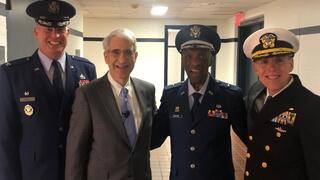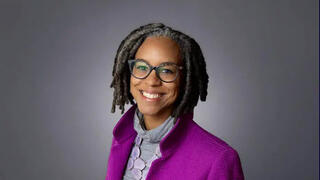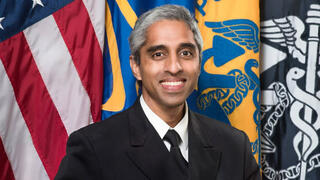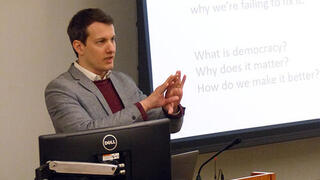Members of the Yale Native American alumni community recently returned to New Haven to celebrate the 10th anniversary of Yale’s Native American Cultural Center (NACC) during the Henry Roe Cloud Conference, a two-day campus event normally held every four years and named after the first Native American to graduate from Yale in 1910.
Formally established in 1993, the NACC originally occupied a single room in the then Chicano Cultural House and later expanded to several rooms at the Asian American Cultural Center before receiving its own building, located on 26 High Street, in 2013, thereby marking a decade in operation.
This occasion held special meaning for many Native alumni.

“The anniversary of the NACC was significant to me because I vividly remember the opening ceremony when I was a junior in college,” said Dinee Dorame ’15, who works at a nonprofit in New Mexico that identifies promising, early-stage innovations to create sustainable solutions for Indigenous communities. “I think we all knew it would change the community to have that kind of space.”
Having previously led Native outreach and recruiting efforts at the Yale Office of Undergraduate Admissions, and purportedly their first Native American staff member, Dorame recalled her student experiences as both challenging and deeply enriching.
“Yale taught me the importance of relationships,” she said. “In some ways, I learned more from my peers in the NACC than anywhere else. I grew so much socially, academically, and personally in the Native community at Yale and I am so appreciative of the people I met as a student.”
Noting the struggles she faced as an undergraduate, she shared a few words of advice for current Native students.
“A huge part of being a Native student on a college campus is to feel like you’re constantly advocating and fighting to be seen, understood, and supported,” she said. “Remember that you don’t have to put the weight of these issues on your back at all times. Don’t be afraid to ask for support and make use of the resources around you. Alumni are cheering you on and want you to have a healthy and happy experience, so make sure you have fun and take time to rest!”
Anya Montiel ’18 PhD, a curator at the Smithsonian’s National Museum of the American Indian in Washington, DC, who was unable to return to campus for the NACC anniversary, was a graduate student pursuing her doctorate in American Studies when the Center transitioned to 26 High Street.
“The building opened my second year at Yale, so I remember the previous space, the tiny rooms on the top floor of the Asian American Cultural Center,” she said. “In 2013, it was very exciting to see an entire building for Native students, programs, and celebrations. I have many fond memories of community dinners, the speaker series, and late-night study sessions.”

Grateful for the world-class libraries, archives, collections, and research materials at Yale that were invaluable to her as a scholar, including the writing of her dissertation about Indigenous art in the United States, Montiel urged current Native students to fully capitalize on the rich academic resources and opportunities that are available to them, both on and off campus.
“I would encourage them to take advantage of various opportunities to do internships, fellowships, and study abroad,” she said. “I spent a month in Australia with other Yale students and learned about Indigenous art in Australia and met with artists. I had never visited Australia before, and I haven’t been able to return.”
Other Native alumni also had thoughts and insights for those following in their footsteps.
“My advice to current Native students is to remember our history as a community and maintain tight connections,” said I’noli Hall ’13, ’22 MDiv, who likewise encouraged students to make the most of everything Yale has to offer. “They should take advantage of those resources, support one another, and exercise self-care.”
The executive pastor of a church in North Carolina, and a member of the Chowanoc Indian Nation, Hall said he benefited tremendously from Yale’s many resources and the support of the Native community on campus.
“The Native community at Yale played a significant role in helping me learn to listen to my advisors, lean on community, and follow my heart,” he said. “Those lessons got me where I am today.”
Joe Jacobs ’77 MD, a retired medical and healthcare professional, and a member of the Kahnawake Mohawk tribe in Canada and the Akwesasne Mohawk tribe in upstate New York, noted that decades ago when he was a student, there were very few Native Americans on campus and not many resources tailored specifically for them; however, the sheer magnitude of Yale’s offerings nonetheless provided an abundance of educational and academic opportunities.
“Yale Medical School became a means to an end, the end being what the rest of Yale had to offer,” he said. “Yale also became a tremendous resource on my Mohawk reservation and its historical significance, as well as a resource for other Native students.”
The youngest of four children and the first in his family to graduate from high school, Jacobs was keenly aware of the value of a top-notch education. Accordingly, he urged current Native students to be highly intentional with theirs.
“Learn as much as you can while here. Learn not only from your faculty but from your colleagues in your classes and community,” he said. “You will realize that anything is possible.”
Other Native alumni who were on campus at the same time as Jacobs remember community building and activism as integral components of their education and student life.
Claudia Emanuel ’79, a retired criminal defense attorney and an enrolled member of the Bay of Quinte Band of Mohawks, Tyendinaga Mohawk Territory, recounted how she, Jacobs, and Drew Ryce ’83 JD co-founded a Native student organization that welcomed new Native students to Yale and hosted many events, including bringing in such prominent speakers as the late-Oglala Lakota activist Russell Means and Pulitzer Prize-winning Kiowa novelist N. Scott Momaday.

Purportedly the only Native American in her Yale College class, Emanuel said that returning to campus to celebrate the NACC’s anniversary held much significance for her.
“The building symbolizes belonging and inclusivity – a rez [reservation] for all,” she said. “When I enter the building, I feel a sense of empowerment. It stands as a pillar of the power of our collective voices and a testament to our strength.”
Mindful that there are many more Native students at Yale today than during her years on campus, she highlighted the importance for them to devote time to foster and cultivate close-knit relationships.
“Find your ‘people,’ your inner circle who will help you navigate, explore, and embark on the many adventures at Yale and beyond,” she said. “Begin your journey at the NACC, and you will form lifelong connections.”
Emanuel expressed her pride that her connection to Yale extended through her two children – Leanne Motylenski ’16 and Matty Motylenski ’20. Both also attended the anniversary event.
Matty, who works as a nonprofit paralegal (and goes by they/them/their pronouns), described why having a place of belonging on campus was, for them, especially important.
“As a Native person coming to terms with my queer identity during college, I felt unique and out of place in several Yale environments initially,” they said. “I carried numerous identities, stories, and histories. While seemingly a burden, I harnessed it to connect with others, to recruit allies, and to represent my people.”
Having served as a peer liaison and house manager at the NACC, Motylenski opined that the Center will continue to play a key role for current and future generations of Native students.
“The NACC represents our anchor, spiritually as a gathering and grounding place, physically as a longstanding structure emblematic that Native people are here, are not invisible, and exist at Yale,” they said, adding that they were encouraged to see the increasing progression of acceptance and belonging on campus. “Community means everything to our people. It warmed my heart to see the Yale Native community continue to become more inclusive and welcoming.”
In addition to being a celebration, the NACC’s 10th anniversary allowed organizers and participants to recognize and acknowledge those who, through collective struggle and effort, helped make the Center’s transition to 26 High Street a reality.

“For decades, alumni and students on campus have advocated for such a space,” said Ashley Hemmers ’07, the chair of Native American Yale Alumni, a shared interest group that connects and serves the Yale Native alumni community. “Now that it exists, I’m hopeful it will help create stronger understandings of how important it is and how crucial it is to support and cultivate relationships beyond graduation for the work we do in our careers and the communities we call home.”
Hemmers, who is the chief administrative officer of her community, the Fort Mojave Indian Tribe, said that while the number of Native Americans within the Yale community is relatively small, they represent a wide range of different customs, beliefs, histories, practices, and cultures—and therefore much can be learned through sharing and communication.
“Sometimes, sharing that we are Native American or Indigenous in older institutions can come with challenges because quite frankly, our communities are both innately diverse with their own unique relationships to the United States,” she said. “The great thing about Yale is that Yalies are interested in learning, and I’ve witnessed how that can go a long way to build bridges between our communities. I think if we start there, there’s a lot of opportunity to support one another.”
Like other alumni, Hemmers stressed the importance for Native students to make the most of their Yale experience.
“Take the time to explore as much as you can,” she said. “Making it your goal to get the most out of your time on campus is the most productive thing you can do for yourself and your community – so please, take advantage of it.”




